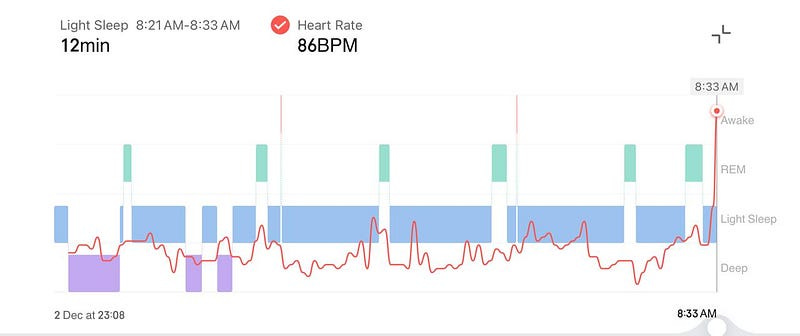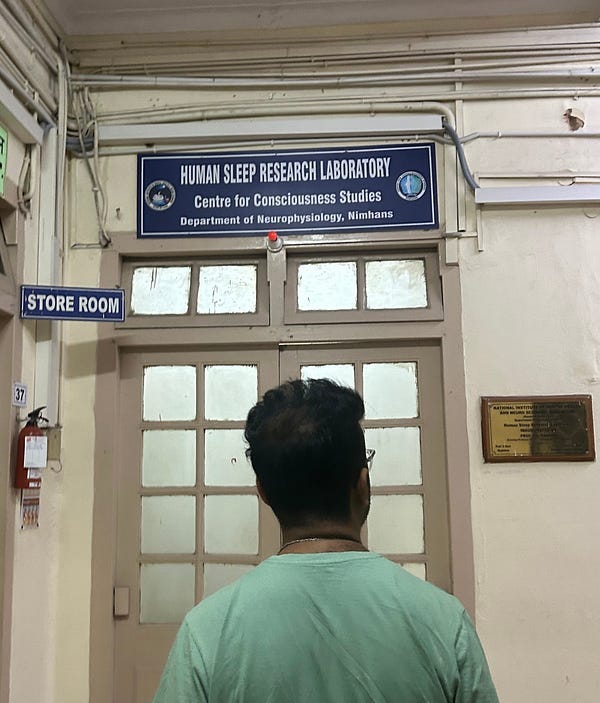What curiosity in sleep led me to ..
In November 2024, I read an introductory book on the brain only to be fascinated by the approach to designing experiements to improve the…
In November 2024, I read an introductory book on the brain only to be fascinated by the approach to designing experiements to improve the organ that controls and co-ordinates our body, the brain! The rabbit hole got deeper with the book phantoms in the brain, understanding the science behind sleep, and then by attending the Sleep Workshop at NIMHANS.
Before the sleep workshop, my understanding of sleep was mostly limited to getting more deep sleep, and dreams occur during REM sleep! I only realized during the workshop that I was completely wrong.

Polysomnography is the gold standard for sleep stage classification, whereby light sleep (Stages N1 & N2), deep sleep (Stage N3), and REM are supposed to be approximately 55%, 20%, and 25%. More deep sleep will lower the amount of REM sleep; hence, having more of any one of these stages might not necessarily mean better sleep. Moreover, these smartwatches and smart rings “estimate” the sleep stages based on pulse and heart rate variability. As per the sleep specialists (pulmonologists, neurologists, etc.), sleep quality cannot be objectively measured like glucose levels or BP. Instead, the best sleep is when you are “fully alert” in the morning, have few to no awakenings during the night, and experience no daytime sleepiness, primarily measured through widely accepted questionnaires such as the PSQI sleep scale.
As a technology person, I went through Amazon to order a ton of sleep products, including sleep (melatonin) gummies, bed cooling systems (Eight Sleep or other alternatives available on Alibaba.com) and a wide range of trackers such as watches, rings, and mattress trackers. I only realized during the workshop that the most effective approach to improving sleep quality is primarily through better sleep hygiene — consistency in lights-off time and waking time, ensuring screen time is minimal after 9 PM so that blue light does not disrupt your circadian rhythm, and avoiding late-night munching or having an early dinner to put your intestines to rest by bedtime. Additionally, I had the myth that snoring is a sign of “sound sleep,” only to realize it is one of the symptoms of a larger underlying condition — obstructive sleep apnea — which requires clinical intervention.
While we all know that sleep improves memory and cognitive functions — spindles was an important concept that amazed me. Sleep spindles are brief, high-frequency brain wave patterns that occur during deep sleep, as shown in the image below.

Sleep spindles occur as part of the brain’s process of consolidating memories from the day, primarily moving information from the hippocampus to the neocortex (parts of our brain) for long-term storage. Additionally, they help with processing emotionally salient memories. There are a lot of interesting studies on spindles leading to interesting conclusions, such as their positive correlation with IQ. In children, high spindle density during the N2 sleep stage supports rapid learning and neurodevelopment. Spindle activity is also used as a biomarker for aging and other conditions such as schizophrenia, MCI, Alzheimer’s, depression, and epilepsy. Surprisingly enough, the characteristics of sleep spindles are so unique to an individual that they can be used as an electrophysiological fingerprint and is genetically inheritable.
While learning about sleep was one aspect of the workshop, talking to neuroscientists working on dream cognition at NIMHANS was eye-opening — specifically inducing lucid dreaming (dreams where you are self-aware that you are in a dream). During childhood, I used to induce lucid dreams unknowingly, and I enjoyed it a lot since I got complete control of my dreams, particularly jumping around the school like Superman! However, these dreams did not last long enough as I would end up waking up. What is interesting is that lucid dreaming is used as a possible therapy to treat PTSD by recreating the scene and completing the unfinished deed. This phenomenon dates back to the Senoi tribe, who had a culture of discussing and sharing dreams to understand an individual’s thought process, which is believed to be the reason they had some of the best mental health.
A few studies also showed that voice or smell-based stimuli during sleep (particularly during the deep sleep phase) could help with treating addictions as well as improving memory consolidation. In one example, a study showed that smokers who received a putrid smell treatment during their deep sleep phase had a 30% chance of reducing smoking in the following week. During the deep sleep phase, these participants were given a putrid smell along with the smell of a cigarette to ensure their brain associated the smell of a cigarette with the putrid smell. In the following week, 30% of the people who received this treatment reduced smoking. In another example, a study showed that auditory stimuli during the deeper phase of sleep improved the ability to solve cognitive tasks amongst youth. During the day, these subjects were given a light background sound while solving cognitive tasks, and the same light sound was played during the deeper phase of sleep when memory consolidation happens. It turns out these people had an improved ability to solve these tasks in comparison to the control group.
While devices like Eight Sleep and Oura Ring offer valuable insights into sleep tracking, there remains an untapped potential to focus on enhancing sleep quality and its impact on cognitive functions. This gap presents an exciting opportunity to create solutions that truly improve quality of life through sleep. If you share this interest or have ideas to contribute, I’d love to connect and discuss potential solutions. Please reach out through this link to schedule a time to talk!



